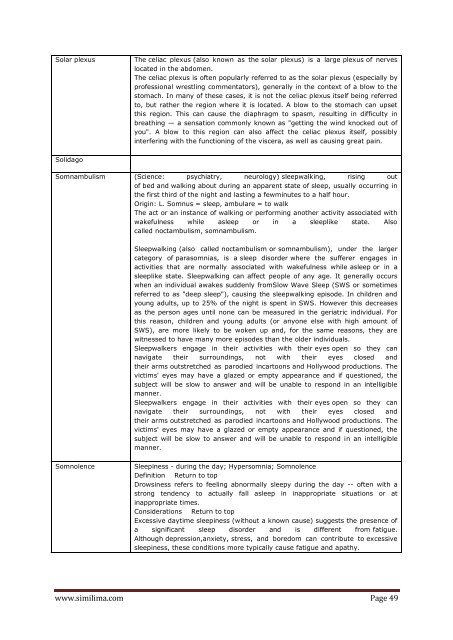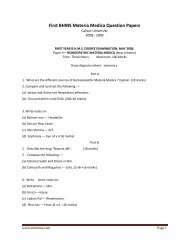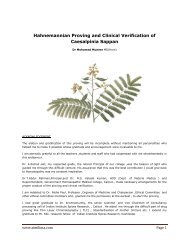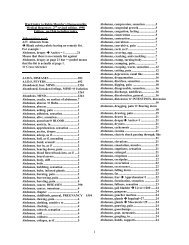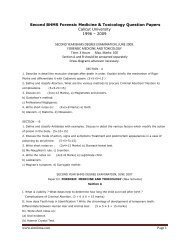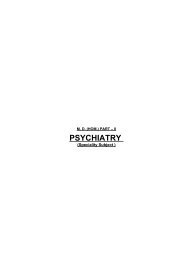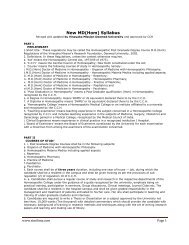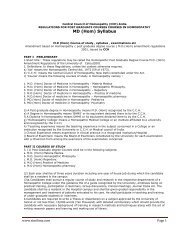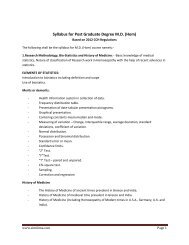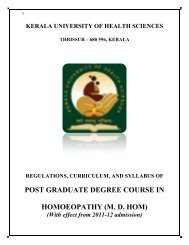Denotations & Old terminologies used in Homopathy - Similima
Denotations & Old terminologies used in Homopathy - Similima
Denotations & Old terminologies used in Homopathy - Similima
You also want an ePaper? Increase the reach of your titles
YUMPU automatically turns print PDFs into web optimized ePapers that Google loves.
Solar plexus The celiac plexus (also known as the solar plexus) is a large plexus of nerves<br />
located <strong>in</strong> the abdomen.<br />
The celiac plexus is often popularly referred to as the solar plexus (especially by<br />
professional wrestl<strong>in</strong>g commentators), generally <strong>in</strong> the context of a blow to the<br />
stomach. In many of these cases, it is not the celiac plexus itself be<strong>in</strong>g referred<br />
to, but rather the region where it is located. A blow to the stomach can upset<br />
this region. This can cause the diaphragm to spasm, result<strong>in</strong>g <strong>in</strong> difficulty <strong>in</strong><br />
breath<strong>in</strong>g — a sensation commonly known as "gett<strong>in</strong>g the w<strong>in</strong>d knocked out of<br />
you". A blow to this region can also affect the celiac plexus itself, possibly<br />
<strong>in</strong>terfer<strong>in</strong>g with the function<strong>in</strong>g of the viscera, as well as caus<strong>in</strong>g great pa<strong>in</strong>.<br />
Solidago<br />
Somnambulism (Science: psychiatry, neurology) sleepwalk<strong>in</strong>g, ris<strong>in</strong>g out<br />
of bed and walk<strong>in</strong>g about dur<strong>in</strong>g an apparent state of sleep, usually occurr<strong>in</strong>g <strong>in</strong><br />
the first third of the night and last<strong>in</strong>g a fewm<strong>in</strong>utes to a half hour.<br />
Orig<strong>in</strong>: L. Somnus = sleep, ambulare = to walk<br />
The act or an <strong>in</strong>stance of walk<strong>in</strong>g or perform<strong>in</strong>g another activity associated with<br />
wakefulness while asleep or <strong>in</strong> a sleeplike state. Also<br />
called noctambulism, somnambulism.<br />
Sleepwalk<strong>in</strong>g (also called noctambulism or somnambulism), under the larger<br />
category of parasomnias, is a sleep disorder where the sufferer engages <strong>in</strong><br />
activities that are normally associated with wakefulness while asleep or <strong>in</strong> a<br />
sleeplike state. Sleepwalk<strong>in</strong>g can affect people of any age. It generally occurs<br />
when an <strong>in</strong>dividual awakes suddenly fromSlow Wave Sleep (SWS or sometimes<br />
referred to as "deep sleep"), caus<strong>in</strong>g the sleepwalk<strong>in</strong>g episode. In children and<br />
young adults, up to 25% of the night is spent <strong>in</strong> SWS. However this decreases<br />
as the person ages until none can be measured <strong>in</strong> the geriatric <strong>in</strong>dividual. For<br />
this reason, children and young adults (or anyone else with high amount of<br />
SWS), are more likely to be woken up and, for the same reasons, they are<br />
witnessed to have many more episodes than the older <strong>in</strong>dividuals.<br />
Sleepwalkers engage <strong>in</strong> their activities with their eyes open so they can<br />
navigate their surround<strong>in</strong>gs, not with their eyes closed and<br />
their arms outstretched as parodied <strong>in</strong>cartoons and Hollywood productions. The<br />
victims' eyes may have a glazed or empty appearance and if questioned, the<br />
subject will be slow to answer and will be unable to respond <strong>in</strong> an <strong>in</strong>telligible<br />
manner.<br />
Sleepwalkers engage <strong>in</strong> their activities with their eyes open so they can<br />
navigate their surround<strong>in</strong>gs, not with their eyes closed and<br />
their arms outstretched as parodied <strong>in</strong>cartoons and Hollywood productions. The<br />
victims' eyes may have a glazed or empty appearance and if questioned, the<br />
subject will be slow to answer and will be unable to respond <strong>in</strong> an <strong>in</strong>telligible<br />
manner.<br />
Somnolence Sleep<strong>in</strong>ess - dur<strong>in</strong>g the day; Hypersomnia; Somnolence<br />
Def<strong>in</strong>ition Return to top<br />
Drows<strong>in</strong>ess refers to feel<strong>in</strong>g abnormally sleepy dur<strong>in</strong>g the day -- often with a<br />
strong tendency to actually fall asleep <strong>in</strong> <strong>in</strong>appropriate situations or at<br />
<strong>in</strong>appropriate times.<br />
Considerations Return to top<br />
Excessive daytime sleep<strong>in</strong>ess (without a known cause) suggests the presence of<br />
a significant sleep disorder and is different from fatigue.<br />
Although depression,anxiety, stress, and boredom can contribute to excessive<br />
sleep<strong>in</strong>ess, these conditions more typically cause fatigue and apathy.<br />
www.similima.com Page 49


